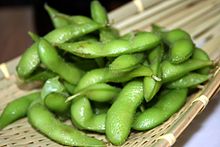 Boiled green soybeans in the pod | |
| Course | Appetizer, side dish |
|---|---|
| Main ingredients | Soybeans |
| Nutritional value per 100 g (3.5 oz) | |||||||||||||||||||||||||||||||||||||||||||||||||
|---|---|---|---|---|---|---|---|---|---|---|---|---|---|---|---|---|---|---|---|---|---|---|---|---|---|---|---|---|---|---|---|---|---|---|---|---|---|---|---|---|---|---|---|---|---|---|---|---|---|
| Energy | 507 kJ (121 kcal) | ||||||||||||||||||||||||||||||||||||||||||||||||
8.9 g | |||||||||||||||||||||||||||||||||||||||||||||||||
| Sugars | 2.18 g | ||||||||||||||||||||||||||||||||||||||||||||||||
| Dietary fiber | 5.2 g | ||||||||||||||||||||||||||||||||||||||||||||||||
5.2 g | |||||||||||||||||||||||||||||||||||||||||||||||||
11.9 g | |||||||||||||||||||||||||||||||||||||||||||||||||
| |||||||||||||||||||||||||||||||||||||||||||||||||
| Other constituents | Quantity | ||||||||||||||||||||||||||||||||||||||||||||||||
| Water | 72.8 g | ||||||||||||||||||||||||||||||||||||||||||||||||
| †Percentages estimated using US recommendations for adults,[1] except for potassium, which is estimated based on expert recommendation from the National Academies.[2] | |||||||||||||||||||||||||||||||||||||||||||||||||
Edamame (枝豆, /ˌɛdəˈmɑːmeɪ/[citation needed]) is a Japanese dish prepared with immature soybeans in the pod. The pods are boiled or steamed and may be served with salt or other condiments. The dish has become popular across the world because it is rich in vitamins, dietary fiber, and isoflavones.[3] When the beans are outside the pod, the term mukimame is also sometimes used in Japanese.[4] Edamame are a common side dish in Japanese cuisine and as an appetizer to alcoholic beverages such as beer or shōchū. As an ingredient Edamame are found in both sweet and savory dishes such as takikomi gohan, tempura, and zunda-mochi.
- ^ United States Food and Drug Administration (2024). "Daily Value on the Nutrition and Supplement Facts Labels". FDA. Archived from the original on 2024-03-27. Retrieved 2024-03-28.
- ^ National Academies of Sciences, Engineering, and Medicine; Health and Medicine Division; Food and Nutrition Board; Committee to Review the Dietary Reference Intakes for Sodium and Potassium (2019). Oria, Maria; Harrison, Meghan; Stallings, Virginia A. (eds.). Dietary Reference Intakes for Sodium and Potassium. The National Academies Collection: Reports funded by National Institutes of Health. Washington, DC: National Academies Press (US). ISBN 978-0-309-48834-1. PMID 30844154. Archived from the original on 2024-05-09. Retrieved 2024-06-21.
- ^ Martin M. Williams, II (27 July 2022). "Editorial: Everything edamame: Biology, production, nutrition, sensory and economics". Frontiers in Plant Science. 13. National Library of Medicine. doi:10.3389/fpls.2022.976008. PMC 9363820. PMID 35968089.
- ^ Johnson, D.; Wang, S.; Suzuku, A (1999). "Edamame: A vegetable soybean for Colorado". Perspectives on New Crops and New Uses: 385–387.